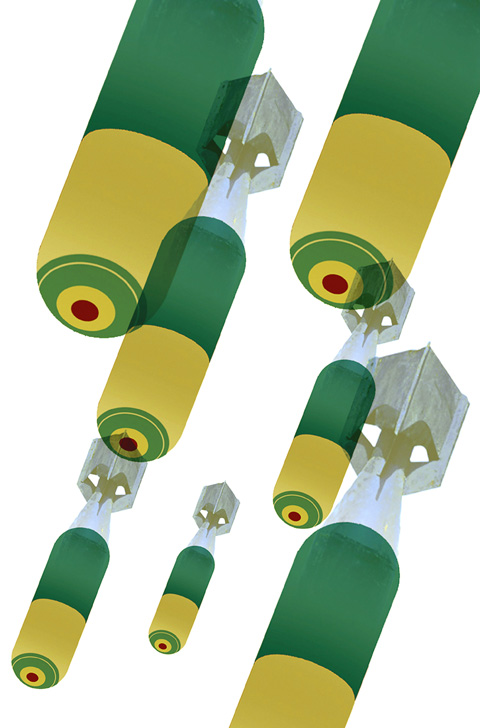A form of substance abuse rampant in the US is rarely discussed publicly or privately. It involves abusing legally sold dietary supplements — vitamins, minerals, herbals and homeopathic remedies — all of which can be sold over the counter without prior approval for safety and effectiveness.
Although there was much publicity about the hazards of ephedra, once widely used as a weight-loss aid until it was found to be deadly, many other heralded dietary supplements have the potential for harm, especially when taken in large doses or in various combinations with one another or with medically prescribed prescription drugs.
Still other problems can arise when these poorly regulated supplements are taken by people with known or hidden health problems or when patients fail to report their use to health professionals who treat them.

ILLUSTRATION: NY TIMES NEWS SERVICE
For example, Richard Nathan, a dental surgeon in San Francisco, wrote in January about a patient who needed a tooth extracted and minor periodontal surgery. She told Nathan that she was taking two drugs, for cholesterol and blood pressure, neither of which he said would present a problem to safe surgery and normal healing.
Thus, Nathan was perplexed when the patient returned five days later unhealed, with an unattached flap of tissue, severe bleeding and an infection.
“Based on my 30 years of experience, it looked as though the patient was an out-of-control diabetic or had a severely compromised immune system,” he told me. “Neither was the case. However, when I asked the patient again what medications she was taking, she admitted that she was on multiple — 18 to be exact — over-the-counter supplements, for a total of 43 pills and capsules a day.”
Six of these — green tea, grape seed, ginkgo biloba, turmeric, salmon oil and vitamin E, he said, “are known to increase bleeding due to inhibition of platelet aggregation,” the first step in forming a clot. Within a week after discontinuing all supplements, her mouth began to heal normally. While this case may represent an extreme, the problem is by no means an isolated one. No one knows how many such adverse effects befall supplement users, because there has been no reliable reporting system.
A new federal law in the US requires supplement manufacturers to report serious adverse effects to the Food and Drug Administration, but it depends on consumers to call in reactions. Experts say most consumers are unlikely to relate health problems to a supplement they assume to be safe, and even if they do, they may be reluctant to report an adverse effect from a self-medicated substance.
Not so for Michael Alexander of San Francisco. In September, he wrote to Kaiser Permanente that a vitamin supplement he had regularly bought from the Kaiser pharmacy caused years of leg cramps, eventually diagnosed by a neurologist as vitamin B6-induced neuropathy. The supplement had 100mg of B6, or 50 times the recommended daily amount. The ill effect developed even though Alexander cut each tablet in four parts and took “only” 25mg daily.
According to a 2002 Harris poll, 70 percent of adults in the US take vitamins, minerals, herbs or other supplements. Their use of supplements has been increasing, fed by the belief that they can make people feel better, give them greater energy, improve health and prevent and treat disease. Although some supplements are beneficial, others may or may not be. Others may be downright dangerous. Even so-called safe supplements can be hazardous in too large amounts or the wrong combinations.
Vitamins A, B6, B12, C, E and K; niacin; folic acid; calcium; magnesium; iron; and zinc can be hazardous when combined with various prescription drugs and over-the-counter remedies. Yet patients often fail to mention using such supplements to physicians.
“Consumers don’t realize that there’s a big difference between dietary supplements, homeopathic remedies and over-the-counter medications,” David Schardt, senior nutritionist for the Center for Science in the Public Interest, a watchdog group in Washington, said in an interview. “They’re all sold side by side in stores. Yet there’s a vast difference in the evidence for safety and effectiveness that manufacturers must have to sell them.”
Over-the-counter medications like ibuprofen, inhalers and reflux inhibitors have to be shown as safe and effective before the FDA will let them be marketed. But thanks to the 1994 Dietary Supplement Health and Education Act, neither dietary supplements nor homeopathic remedies are required to provide pre-market evidence of safety and effectiveness. To remove such a product from the market, the FDA must prove that it is dangerous, a challenging task for the understaffed, budget-strapped agency. Homeopathic remedies slip under an even lower wire. While dietary supplements can make only structure and function claims, products labeled homeopathic — a designation decided by the industry, not the FDA — can assert medical effects, Schardt explained. Thus, the homeopathic zinc supplement Cold-EEZE, claims to fight colds, but Cold-fX, sold as a zinc dietary supplement, cannot make such a claim.
Consumers are often swayed by reports of health benefits attributed to various supplements, and assume that they are risk-free and can be safely taken in any amount. Although a small dose may be good, more is not necessarily better. In fact, it may be harmful. Megadoses of vitamins or minerals are no longer acting as nutrients but as drugs or, in some cases, as toxic agents.
For example, observational studies of people who eat foods rich in antioxidants like vitamins A and E and beta-carotene have suggested these substances improve health. But well-designed clinical trials found increased death rates among people who take them as supplements. And while low vitamin C doses can suppress harmful free radicals, very high doses promote their formation. The initial promise that vitamin E could protect against heart attacks and cancer failed to stand up to scientific scrutiny, which instead found that it increased the risk of heart failure.
Led by testimonials and articles in health-food publications and on the Internet, consumers also tend to confuse structure and function claims with medical benefits. They are not the same. Just because beta-carotene in carrots aids normal vision does not mean it can correct nearsightedness. Or a substance for forming blood cells will not necessarily be useful to prevent or treat a disease of blood-forming tissue like leukemia.
A National Institutes of Health panel in May 2006 noted: “The FDA has insufficient resources and legislative authority to require specific safety data from dietary supplement manufacturers or distributors before or after their products are made available to the public. The constraints imposed on FDA make it difficult for the health of the American public to be adequately protected.”
Caveat emptor.

Feb. 17 to Feb. 23 “Japanese city is bombed,” screamed the banner in bold capital letters spanning the front page of the US daily New Castle News on Feb. 24, 1938. This was big news across the globe, as Japan had not been bombarded since Western forces attacked Shimonoseki in 1864. “Numerous Japanese citizens were killed and injured today when eight Chinese planes bombed Taihoku, capital of Formosa, and other nearby cities in the first Chinese air raid anywhere in the Japanese empire,” the subhead clarified. The target was the Matsuyama Airfield (today’s Songshan Airport in Taipei), which

China has begun recruiting for a planetary defense force after risk assessments determined that an asteroid could conceivably hit Earth in 2032. Job ads posted online by China’s State Administration of Science, Technology and Industry for National Defence (SASTIND) this week, sought young loyal graduates focused on aerospace engineering, international cooperation and asteroid detection. The recruitment drive comes amid increasing focus on an asteroid with a low — but growing — likelihood of hitting earth in seven years. The 2024 YR4 asteroid is at the top of the European and US space agencies’ risk lists, and last week analysts increased their probability

On Jan. 17, Beijing announced that it would allow residents of Shanghai and Fujian Province to visit Taiwan. The two sides are still working out the details. President William Lai (賴清德) has been promoting cross-strait tourism, perhaps to soften the People’s Republic of China’s (PRC) attitudes, perhaps as a sop to international and local opinion leaders. Likely the latter, since many observers understand that the twin drivers of cross-strait tourism — the belief that Chinese tourists will bring money into Taiwan, and the belief that tourism will create better relations — are both false. CHINESE TOURISM PIPE DREAM Back in July

Could Taiwan’s democracy be at risk? There is a lot of apocalyptic commentary right now suggesting that this is the case, but it is always a conspiracy by the other guys — our side is firmly on the side of protecting democracy and always has been, unlike them! The situation is nowhere near that bleak — yet. The concern is that the power struggle between the opposition Chinese Nationalist Party (KMT) and their now effectively pan-blue allies the Taiwan People’s Party (TPP) and the ruling Democratic Progressive Party (DPP) intensifies to the point where democratic functions start to break down. Both